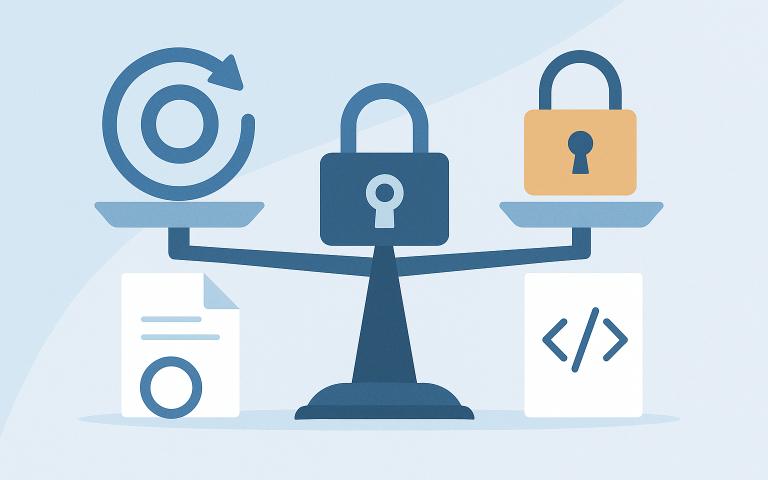Open Source with a Catch: What Copyleft Really Means
Open source doesn’t always mean “do whatever you want.” Copyleft licenses (like GPL and AGPL) give you freedom to use and modify code—on the condition that you share your changes, too. If you miss that condition, you can accidentally “open” your entire product. Here’s a plain-English tour of what copyleft is, why it matters, and how to avoid nasty surprises.

Copyleft in one sentence
Copyleft means: “You received freedom—pass it on.” If you use or modify copylefted code in your product, you must make your resulting code available under the same terms.
Think of it like a recipe: you get a pizza recipe, improve it, and sell your version—but you also publish your updated recipe so others can benefit, too.
Why this exists
In the 1980s, companies started closing software built on community work. Copyleft (via the GNU GPL) flipped the script: you can use and improve the code, but your improvements stay open to everyone. This principle helped grow Linux, WordPress, VLC, Blender, and more.
Business impact: what actually happens
- If you distribute a product that includes GPL code, you must provide your source code to users under the GPL.
- If you run a network service (SaaS) using AGPL code, you must offer your modified source to users who interact with it over the network.
- If you only link to an LGPL library, you usually don’t need to open your whole app—only your changes to the library itself.
Bottom line: strong copyleft (GPL/AGPL) can “pull” your app into open source if you combine it closely enough. That’s why many commercial products prefer permissive licenses (MIT, BSD, Apache) in their dependency trees.
Types of licenses—quick clarity
| License type | What it requires | Common licenses | Typical use case |
|---|---|---|---|
| Strong copyleft | Distribute code → share source of the whole combined work | GPL, AGPL | Community projects that want improvements to stay open |
| Weak copyleft | Share changes to the library; app can remain closed | LGPL, MPL | Reusable libraries intended for broad adoption |
| Permissive | Keep notices; otherwise do almost anything | MIT, BSD, Apache-2.0 | Commercial apps, frameworks, internal tools |
Concrete scenarios (so it’s not abstract)
1) WordPress plugin under GPL
You buy a premium plugin (GPL). You can use it on unlimited sites and even share the code you received. Vendors often sell services—automatic updates and support—tied to a license key. The code must work without keys; the services can be restricted.
2) SaaS + AGPL dependency
Your backend uses an AGPL component. Because users interact with your service over a network, the AGPL requires offering your modified source to those users. Many SaaS products avoid AGPL for this reason.
3) Desktop app + GPL library
If you ship a desktop app that incorporates a GPL library (not just dynamically linking in a clearly separable way), you’ll likely need to release your app’s source under the GPL when distributing binaries.
4) Using an LGPL library
LGPL allows linking without opening your entire app, but you must allow users to replace or relink the LGPL component and publish changes you make to that component.
What happens if you ignore copyleft
- Legal risk: violation of copyright, takedown requests, forced disclosure, or settlement costs.
- Operational cost: emergency refactors to remove/replace components; delayed releases.
- Reputation risk: public compliance issues hurt hiring, partnerships, and community trust.
How to stay safe (fast checklist)
- Check the license before you install. Don’t add unknown GPL/AGPL deps to commercial or closed-source products.
- Prefer permissive licenses (MIT/BSD/Apache) for business-critical paths.
- Document your dependency tree. Keep a bill of materials (SBOM) and review transitive deps.
- Separate services from code. If you sell plugins/tools, tie revenue to support/updates, not to restricting the code itself.
- Have a fallback plan. If a copyleft dep sneaks in, know the alternative you can swap to.
Not anti-business—just clear rules
Copyleft isn’t about blocking revenue; it’s about keeping community improvements available. If your strategy embraces open collaboration, copyleft protects your investment. If you ship proprietary products, treat copyleft like a contract: understand it before you integrate.
Takeaway
Open source ≠ license-free. Copyleft grants freedom with a condition: share forward. Read the license, choose dependencies intentionally, and you’ll avoid the “we must open our entire codebase” surprise.
Get in touch
Need an external audit of Your project?
Tell us your context and the outcome you want, and we’ll suggest the simplest next step.